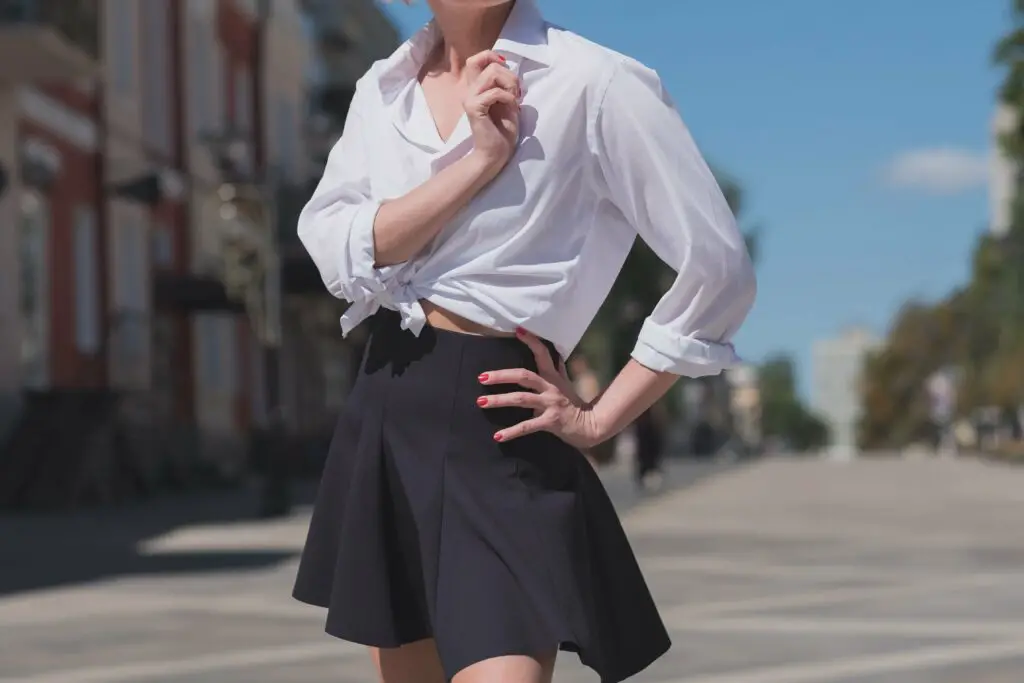Skirts that are too short have long been a subject of debate and discussion in the world of fashion. The length of a skirt plays a crucial role in defining one’s style, making it an essential aspect of personal expression. This article aims to delve into the topic of skirts that are too short, exploring its definition, highlighting the importance of discussing skirt length, and providing a clear purpose for the article.
Skirts that are too short refer to hemlines that are significantly above the knee, often pushing the boundaries of conventional skirt lengths. While the exact measurement may vary, these skirts typically expose a considerable amount of leg, raising questions of appropriateness and societal standards.
The length of a skirt holds cultural, social, and professional significance. It not only reflects individual style choices but also communicates messages about modesty, professionalism, and adherence to social norms. Understanding the importance of discussing skirt length allows for a more informed approach to fashion choices and their impact on personal image and perception.
The purpose of this article is to explore the multifaceted aspects surrounding skirts that are too short. By examining cultural perspectives, societal expectations, and personal comfort, we aim to provide readers with insights and considerations to make informed decisions about their own skirt lengths. Furthermore, we seek to promote a healthy and inclusive discussion about fashion choices, encouraging individuals to strike a balance between self-expression and appropriateness.
As we delve into the following sections, we will navigate the complex terrain of skirt length, examining its cultural implications, social acceptance, occasion-specific considerations, personal comfort, and empowering choices. By the end of this article, readers will gain a deeper understanding of the factors influencing skirt length choices and be better equipped to navigate the fashion landscape with confidence and style.
Contents
 Cultural Perspectives on Skirt Length
Cultural Perspectives on Skirt Length
Skirt length is not solely determined by individual preference but is deeply influenced by cultural perspectives and norms. Understanding how different cultures perceive skirt length is essential in appreciating the diversity of fashion and promoting cultural sensitivity. In this section, we will explore the various cultural perspectives on skirt length, the cultural factors that shape these perspectives, and provide examples of varying cultural norms.
Skirt length preferences vary across cultures, ranging from conservative to more liberal attitudes. Some cultures prioritize modesty and prefer longer skirts that cover the knees, while others embrace shorter lengths as a form of self-expression and fashion-forwardness. Examining these differing perceptions helps us appreciate the rich tapestry of global fashion traditions.
Cultural factors play a significant role in determining the appropriateness of skirt length. These factors include religious beliefs, social norms, historical influences, and traditional gender roles. For instance, in conservative societies, skirt length may be closely tied to notions of decency and respectability, while in more progressive cultures, individual freedom and self-expression may take precedence.
Examples of cultural norms related to skirt length are diverse and fascinating. In some Middle Eastern countries, women often wear long skirts or dresses as a symbol of modesty and religious observance. Traditional Japanese attire, such as the kimono, features ankle-length skirts as a reflection of cultural aesthetics and customs. In contrast, Western cultures have seen shifts in skirt length trends over the decades, from the longer hemlines of the Victorian era to the iconic mini-skirt revolution in the 1960s.
Skirt Length and Social Acceptance
Skirt length is not only influenced by individual preferences but is also shaped by societal standards and expectations. In this section, we will explore how society’s norms play a significant role in determining acceptable skirt lengths. We will examine the historical evolution of skirt length, the influence of fashion trends, and the media’s impact on shaping social acceptance.
Society sets guidelines and expectations regarding skirt length, often based on cultural, moral, and practical considerations. These standards vary across different communities and can be influenced by factors such as social class, age, and geographical location. Societal expectations help establish a common understanding of what is considered appropriate and modest in a given context.
Skirt length has undergone significant changes throughout history. In different eras, societal attitudes, cultural shifts, and fashion movements have influenced the acceptable length of skirts. For example, during the Victorian era, ankle-length skirts were the norm, symbolizing modesty and femininity. In contrast, the 1920s witnessed the rise of flapper fashion, featuring daringly short skirts as a rebellion against societal constraints.
Fashion trends and the media play a vital role in shaping social acceptance of skirt length. Designers, celebrities, and influencers often set the tone for what is considered fashionable and acceptable. The media’s portrayal of certain skirt lengths can influence public perception and reinforce beauty standards. Fashion magazines, movies, and television shows can heavily influence the popularity and acceptance of different skirt lengths in mainstream culture.
Setting the Scene: Appropriate Skirt Lengths for Different Occasions
Skirt length appropriateness varies depending on the occasion and setting. Different environments have specific expectations and dress codes that individuals should consider when choosing the length of their skirts. In this section, we will explore appropriate skirt lengths for professional environments, casual settings, and formal occasions, highlighting the importance of dressing appropriately for each context.
In professional settings such as offices, workplaces, or formal business events, it is generally expected to adhere to a more conservative dress code. Skirts that are too short may be deemed inappropriate and unprofessional. It is recommended to opt for skirt lengths that fall at or slightly above the knee, ensuring a polished and respectful appearance.
Casual settings and social events offer more flexibility when it comes to skirt length. However, it is still essential to consider the occasion and venue. For casual outings with friends or informal gatherings, slightly shorter skirts may be acceptable, depending on personal comfort and the overall style of the event. Nevertheless, it is important to exercise discretion and dress in a manner that aligns with the social atmosphere and expectations.
Formal occasions, such as weddings, galas, or black-tie events, often require a higher level of elegance and adherence to dress etiquette. Longer skirt lengths are generally preferred for these events, as they convey a sense of sophistication and formality. Floor-length or tea-length skirts are commonly seen in formal dress codes, allowing individuals to make a graceful and refined impression.
When considering appropriate skirt lengths for different occasions, it is crucial to also refer to specific dress codes if they are provided. These guidelines offer valuable insights into the expected attire, ensuring that individuals dress appropriately and respectfully within the given context.
 Personal Comfort and Confidence: Finding the Right Skirt Length
Personal Comfort and Confidence: Finding the Right Skirt Length
Finding the right skirt length is not only about adhering to societal norms but also about prioritizing personal comfort and confidence. It is essential to consider individual body types, embrace personal style, and strike a balance between self-expression and appropriateness. In this section, we will explore how to navigate these factors and provide tips for determining the ideal skirt length.
- Individual body types and preferences: Different skirt lengths can flatter different body types. Understanding your body shapes, such as pear, hourglass, or apple, can help in choosing a skirt length that accentuates your best features. For instance, A-line or midi-length skirts can be flattering on various body types, while mini-skirts or maxi skirts may require careful consideration. Ultimately, personal comfort and confidence should guide your choices, allowing you to feel at ease in your own skin.
- Embracing personal style while respecting appropriateness: Finding the right skirt length involves balancing personal style with appropriateness for the occasion. Experiment with different lengths that align with your fashion preferences while considering the setting, cultural norms, and dress codes. Incorporate your unique sense of style through fabric choices, patterns, or accessories, allowing your personality to shine while still maintaining an appropriate appearance.
- Tips for determining the ideal skirt length:
- Experiment and try on different skirt lengths to see how they look and feel on you.
- Consider the occasion, setting, and dress code guidelines to gauge appropriate lengths.
- Take into account the weather and practicality of the skirt length for the specific situation.
- Pay attention to the proportions of your outfit, ensuring the skirt length complements your top and shoes.
- Seek feedback from trusted friends or stylists to get different perspectives and insights.
Addressing the Risks of Skirts That Are Too Short
While personal style and fashion choices are important, it is essential to be aware of the potential risks associated with skirts that are too short. In this section, we will explore some of these risks, particularly in professional settings, and provide tips on ensuring comfort, freedom of movement, and avoiding wardrobe malfunctions.
Wearing skirts that are too short in professional environments can have consequences for one’s reputation and career. It may be perceived as unprofessional and can negatively impact how others perceive your professionalism and competence. It is crucial to adhere to dress codes and company policies to maintain a polished and appropriate image in the workplace.
Skirts that are excessively short may compromise comfort and freedom of movement. A skirt that is too short can restrict your mobility and make you feel self-conscious or uncomfortable throughout the day. It is important to choose a skirt length that allows you to move freely, sit comfortably, and go about your daily activities without any hindrance.
Short skirts can increase the risk of wardrobe malfunctions, such as unintentional exposure or discomfort caused by constantly readjusting the skirt. When choosing a skirt length, consider the fabric, fit, and structure to ensure it stays in place and maintains modesty. Additionally, wearing appropriate undergarments can provide an added layer of security and prevent any wardrobe mishaps.
 Conclusion
Conclusion
We have explored the topic of skirts that are too short, delving into various aspects of cultural perspectives, social acceptance, appropriate lengths for different occasions, personal comfort, and overcoming judgment. Let’s recap the key points discussed and emphasize the importance of finding the right balance, embracing self-expression, and having confidence in personal style.
We began by defining the topic and highlighting the significance of discussing skirt length, considering the cultural perspectives and factors influencing the appropriateness of skirt lengths. We then explored how societal standards, historical influences, and fashion trends impact the social acceptance of skirt lengths.
Furthermore, we discussed the importance of understanding appropriate skirt lengths for different occasions, including professional settings, casual environments, and formal events. By adhering to dress codes and considering the expectations of each setting, individuals can navigate fashion choices effectively.
We addressed the potential risks of wearing skirts that are too short, such as professional consequences, comfort issues, and wardrobe malfunctions. By being mindful of these risks, individuals can make informed decisions and prioritize their well-being and appropriate presentation.
To empower individuals in their fashion choices, we provided tips for styling shorter skirts tastefully, including balancing proportions, layering with appropriate garments, and experimenting with textures and patterns. We also emphasized the importance of embracing personal style and self-expression while respecting societal norms and guidelines.
Finding the right balance when it comes to skirt length is essential. It involves considering cultural perspectives, adhering to appropriate lengths for different occasions, and prioritizing personal comfort and self-expression. By embracing individual style, having confidence in personal choices, and respecting others’ fashion decisions, we can create a fashion landscape that celebrates diversity and empowers individuals to express themselves authentically.
Remember, fashion is an art form, and your style is a reflection of your unique personality. Embrace the journey of exploring different skirt lengths, experimenting with styling techniques, and finding the balance that makes you feel comfortable, confident, and true to yourself. Ultimately, your fashion choices should be a celebration of your individuality and a source of empowerment.
Want to know How to wear a headscarf without cultural appropriation? Read it here.





